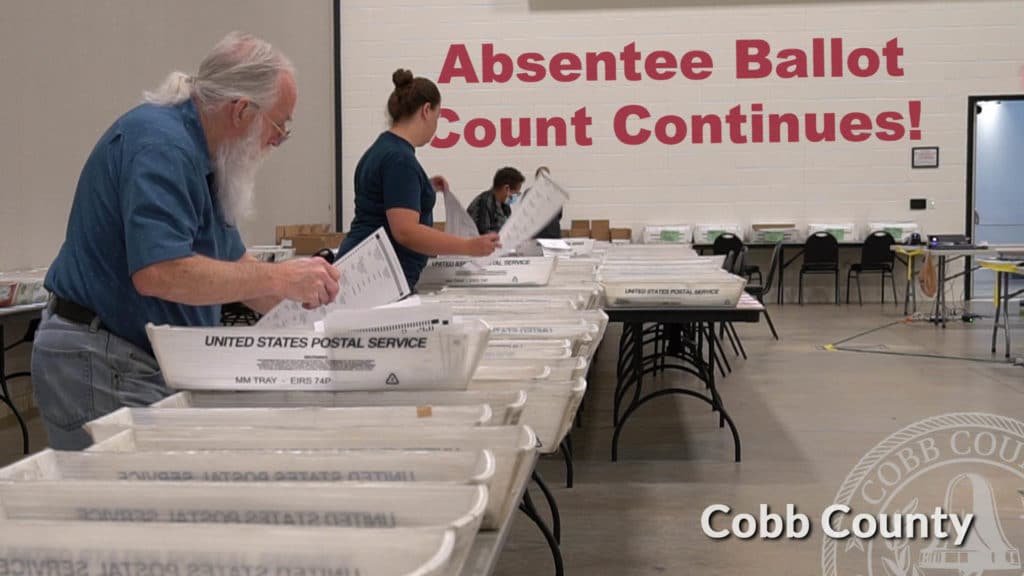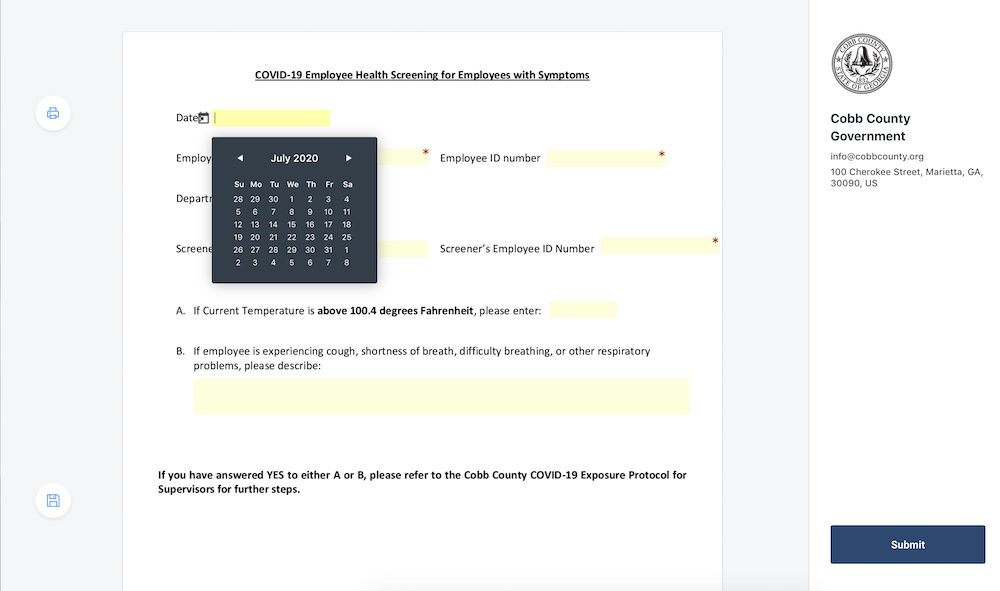On June 16th we spoke with Tara Crisp of Cobb County to learn a little more about what her agency has done to respond to the COVID pandemic. In this article, you can listen to her interview in the audio clip, or read the transcription.
(This is an audio only file, like a podcast. The video image will not change.)
Karl Pawlewicz (KP): The COVID-19 pandemic has really hit a lot of municipalities very hard. We’ve certainly seen it with a lot of the municipalities that SeamlessDocs works with, and we’ve seen a lot of municipalities have moved very quickly to respond to the needs of their citizens as well as their employees. So one of the things we’re trying to do in these conversations is shine a little light on the creative, innovative thinking that local government has employed to help get them through this pandemic.
Can you start by telling us a bit about your municipality?
Tara Crisp (TC): I’m Tara Crisp, and I am a technology services manager and I work in our tech / information services department. I serve and support my direct team, several departments across the County, our citizens and our other internal customers within our County.
Cobb County has over 700,000 in population. We’re a Metro County right outside of Atlanta. So we’re big and always growing. We have about 5,000 employees and we have about 100 people in our department that support all the other users in the County.
KP: What’s been the biggest learning for you and the team there at Cobb County since this pandemic started?
TC: Before the pandemic hit, our department took care of a lot of the web conferencing needs—help people set things up, help them run web interviews and things of that sort. We realized when this started happening that we didn’t have enough licenses to fully support the need that we had within our County for people to be able to do all the web conferencing they needed to do to stay in contact with their employees and with their citizens. We really had to do some very quick training for everyone, but to do that we had to do the training ourselves so we could then walk other people through how to use all the new web conferencing technology we acquired.
What was funny to see was people paying so much more attention to all the different brands of technology available and asking, “Hey do we use this?” or “Hey, we want that!” And our response was typically something, “Even if we don’t have a certain product we do have all the capabilities we need to make meetings happen.” It’s like they wanted Pepsi and we have Coke. So we had to help everyone understand that all web conferencing technology is very comparable and we have what it takes to still get things done remotely. We’re a Cisco shop, so we’ve been using Cisco WebEx and WebEx Events.
It was most challenging in the first month, because there were a lot of contracts that needed to get approved so we could move forward with regularly scheduled meetings, like our board commissioner meeting. For that public meeting we need all of our citizens to be able to see the meeting and have input if needed. And we had to figure out how to give them all access to these meetings. We did some practice runs having the board set up technology at home and figure out how they could all be present.
We turned to SeamlessDocs to help us get started and get citizens signed up to speak at these public events. It was easy to create a SeamlessDocs that we could put on the web and invite people to sign up to speak at our next meeting. Then we would contact those citizens and give them instructions on how to join the web conference and speak during their allotted time.
KP: Could you talk a little bit about the recent meeting and the citizen engagement in it?
TC: The Cobb County board of commissioners have been trying to draft some language to condemn racism in our County. We felt strongly that citizens should hear that language and have their feedback on it heard. So we used SeamlessDocs to allow citizens to sign up and speak at the meeting. Typically we allow 12 citizens to sign up, but given the important nature of this meeting, we felt like we should allow more citizens to participate.
Ultimately we had 27 people sign up to speak, which was a surprise, but it was great to have the process managed using a SeamlessDoc. We were able to go directly into the backend, download all the sign-ups and reach out to everyone directly in a short period of time to prepare them for the meeting. In the end we had 20 citizens who showed up to share their feedback live in the meeting. I think their feedback was very important and instrumental to the board of commissioners in formulating their final language of the resolution that they approved that night.
It was also very useful to have that SeamlessDocs link to the sign-up form because then each of the commissioners was able to post that on their social media profiles and spread the word with constituents. It underscored the inclusion of our community and organization and provided a clear way to make their voices heard. It all worked out very well.
KP: For your local government, what’s been the biggest challenge since the pandemic started?
TC: For us, initially, it was equipment. We had about 24 hours notice that our team would be going remote. So we were like, “Hey, everybody needs a laptop” and we didn’t have that many on hand, nor did we have tablets and webcams. And we couldn’t get those things at that time because there were backorders on tablets and things like that. It’s all much better now but in the beginning it was a challenge. We’re lucky to have very good partnerships with our vendors so they were able to quickly give us the resources we needed for employees and citizens.
I think one of the challenges we continue to have, and I think we will for a long time is with elections. That’s been a challenge because we’ve had so many absentee ballots and those have to be handled in a very manual kind of way. I think this will be a challenge for a long time.
Unfortunately here in Georgia we received brand new election voting machines this year. So you can imagine having brand new machines and a lot fewer poll workers than we typically (because of COVID) and we didn’t have an opportunity to train workers in person like we would.
It’s challenging too because there’s a limit to how much technology you can really incorporate. Votes have to be legally done by comparing signatures to voter registrations. So that’s something we still are struggling with, but our team is doing a great job given the circumstances. It’s been tough and I think we’ve learned a lot. We just had the primary elections last week and they’re still counting absentee ballots because a lot of them came in damaged and they just couldn’t be scanned the same way. Some of them had tears and things like that, so all of the counting has to be done manually, double checking votes to ensure they’re being recorded correctly.

KP: Are there any processes that have changed as a result of the pandemic that you think will be permanent?
TC: Well, I think it’s gonna be a long time before everyone’s all in a small meeting room again!
I think for us we were in a very fortunate place with our use of SeamlessDocs. We’ve been using SeamlessDocs for a couple of years now and I’ve been a huge proponent of the solution for a long time, because I think it’s such an easy solution and it gives us the ability to come up with a solution for different problems in a very quick manner.
I feel like there’s been a huge gap in some of the services we’ve been able to provide that SeamlessDocs has filled. Since the IT team has been using SeamlessDocs I’ve been telling my peers about it and encouraging them to use it too. Initially we bought only a handful of licenses, and now we have many, many more because more and more people on our team were coming to me saying, “Hey, I need to be able to do this.” And it’s always very encouraging as an IT person, when your users are coming to you saying, “Hey, I want to be able to use this tool. I want to be able to create things.”
A lot of times that doesn’t happen in it. A lot of times, it’s more like we’re pushing new solutions on people because they don’t immediately see the benefits of how it can help their lives and help their work lives. That’s not the case with SeamlessDocs. I think that people who see it and have used it a couple of times, their reaction is, “Oh my gosh, I can do this. And I can use it for this and I can use it for that.” It’s really, it’s really amazing from that perspective and I don’t know that I’ve ever seen another solution embraced as quickly. But our team has picked up very quickly and just run with it.
That’s great in two ways: in one way it’s making their lives easier, which is great to see; and at the same time it’s making our lives easier because that’s one less thing that we have to create for them. It gives us more bandwidth to be able to address more challenging problems.
Cobb County Form Examples


All of these forms have been very useful for us. They help us limit the number of people in the office or in a meeting room at the same time. With the Families First Coronavirus Response Act we were able to create forms for requesting time off. With online forms, everyone can get access from home, and they can sign and submit something even if they don’t have a printer. That was incredibly helpful.
I think that all of these digital, online processes that we’ve created over the last few weeks and months will remain in place for a long time. I know it’s kind of dorky, but it’s very exciting for me as an IT person.
KP: Can you share some examples of how Cobb County has used its online services to work with local businesses?
KP: I know a lot of municipalities now are also looking for ways to empower local businesses and give them access to CARES Act funding or give them a clear path on who can and cannot return to business.
TC: Over the years we’ve asked businesses come into the offices for things like inspections, paying for business licenses, erosion control and other services. When COVID happened, the County wasn’t closed but we were on limited operations. We could help people in person, but we only had one or two people in the office at a time, so any in-person transaction became very time consuming. We used SeamlessDocs to bring a lot of those services online and we saw that a lot more people embraced doing things online. Presumably because they were more comfortable with that than coming into the office, and because it could help keep things moving along faster.
KP: Is there something you’d like to say to other local government counterparts out there – words of wisdom or words of encouragement?
TC: It’s all about service. You have to keep doing your best—keep pushing forward—and finding the best way to do the best for your citizens and for the other employees in your municipality. I hope that people are gonna grow more comfortable with the technology that’s out there and that’s available to them and realize that they really will benefit from using it more.









